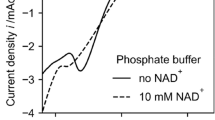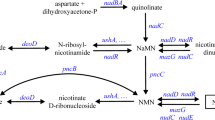Abstract
Objectives
To find an efficient and cheap system for NAD+ regeneration
Results
A NADH-ferricyanide dehydrogenase was obtained from an isolate of Escherichia coli. Optimal activity of the NADH dehydrogenase was at 45 °C and pH 7.5, with a K m value for NADH of 10 μM. By combining the NADH dehydrogenase, potassium ferricyanide and laccase, a bi-enzyme system for NAD+ regeneration was established. The system is attractive in that the O2 consumed by laccase is from air and the sole byproduct of the reaction is water. During the reaction process, 10 mM NAD+ was transformed from NADH in less than 2 h under the condition of 0.5 U NADH dehydrogenase, 0.5 U laccase, 0.1 mM potassium ferricyanide at pH 5.6, 30 °C
Conclusion
The bi-enzyme system employed the NADH-ferricyanide dehydrogenase and laccase as catalysts, and potassium ferricyanide as redox mediator, is a promising alternative for NAD+ regeneration.






Similar content being viewed by others

References
Aksu S, Arends IWCE, Hollmann F (2009) A new regeneration system for oxidized nicotinamide cofactors. Adv Synth Catal 351:1211–1216
Bommarius AS, Schwarm M, Drauz K (1998) Biocatalysis to amino acid-based chiral pharmaceuticals-examples and perspectives. J Mol Catal B Enzym 5:1–11
Chenault HK, Whitesides G (1987) Regeneration of nicotinamide cofactors for use in organic synthesis. Appl Biochem Biotechnol 14:147–197
Chenault HK, Whitesides GM (1989) Lactate dehydrogenase-catalyzed regeneration of NAD from NADH for use in enzyme-catalyzed synthesis. Bioorg Chem 17:400–409
Geueke B, Riebel B, Hummel W (2003) NADH oxidase from Lactobacillus brevis: a new catalyst for the regeneration of NAD. Enzym Microb Technol 32:205–211
Grunwald J, Wirz B, Scollar MP, Klibanov AM (1986) Asymmetric oxidoreductions catalyzed by alcohol dehydrogenase in organic solvents. J Am Chem Soc 108:6732–6734
Itoh S, Terasaka T, Matsumiya M, Komatsu M, Ohshiro Y (1992) Efficient NAD+-recycling system for ADH-catalysed oxidation in organic media. J Chem Soc Perkin Trans 1:3253–3254
Jouanneau Y, Meyer C, Jakoncic J, Stojanoff V, Gaillard J (2006) Characterization of a naphthalene dioxygenase endowed with an exceptionally broad substrate specificity toward polycyclic aromatic hydrocarbons. Biochemistry 45:12380–12391
Kaswurm V, Hecke WV, Kulbe KD, Ludwig R (2013) Guidelines for the application of NAD(P)H regenerating glucose dehydrogenase in synthetic processes. Adv Synth Catal 355:1709–1714
Kulikova VS (2005) NADH oxidase activity of gold nanoparticles in aqueous solution. Kinet Catal 46:373–375
Lee LG, Whitesides GM (1985) Enzyme-catalyzed organic synthesis: a comparison of strategies for in situ regeneration of NAD from NADH. J Am Chem Soc 107:6999–7008
Riebel BR, Gibbs PR, Wellborn WB, Bommarius AS (2003) Cofactor regeneration of both NAD+ from NADH and NADP+ from NADPH: NADH oxidase from Lactobacillus sanfranciscensis. Adv Synth Catal 345:707–712
Šalić A, Ivanković M, Ferk E, Zelić B (2013) ADH based NAD+ regeneration in a microreactor. J Chem Technol Biotechnol 88:1721–1729
Wang P, Yang J, Jiang L, Feng J, Yang C, Li D (2013) A bi-enzymatic system for efficient enantioselective bioconversion of racemic mandelic acid. J Mol Catal B Enzym 94:47–50
Weckbecker A, Groger H, Hummel W (2010) Regeneration of nicotinamide coenzymes: principles and applications for the synthesis of chiral compounds. Biosyst Eng I:195–242
Supplementary information
Supplementary Fig. 1—Lineweaver-Burk plot of the effect of NADH concentration on NADH dehydrogenase activity. Enzyme kinetic parameters were obtained by measuring the rate of A340 value decrease at various concentrations of NADH ranging from 12.5 μM to 400 μM at 45 °C in Tris/HCl buffer (pH 7.5, 50 mM).
Supplementary Fig. 2—Lineweaver-Burk plot of the effect of potassium ferricyanide concentration on NADH dehydrogenase activity. Enzyme kinetic parameters were obtained by measuring the rate of A340 value decrease at various concentrations of potassium ferricyanide ranging from 6.25 μM to 200 μM at 30 °C in citrate/phosphate buffer (pH 5.6, 50 mM).
Supplementary Fig. 3—Residual activity of NADH dehydrogenase and laccase following incubation at 30 °C in citrate/phosphate buffer (pH 5.6, 50 mM).
Author information
Authors and Affiliations
Corresponding author
Additional information
Jizhong Wang and Chengli Yang have contributed equally to this work.
Electronic supplementary material
Below is the link to the electronic supplementary material.
Rights and permissions
About this article
Cite this article
Wang, J., Yang, C., Chen, X. et al. A high effective NADH-ferricyanide dehydrogenase coupled with laccase for NAD+ regeneration. Biotechnol Lett 38, 1315–1320 (2016). https://doi.org/10.1007/s10529-016-2106-3
Received:
Accepted:
Published:
Issue Date:
DOI: https://doi.org/10.1007/s10529-016-2106-3



